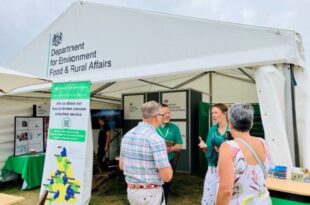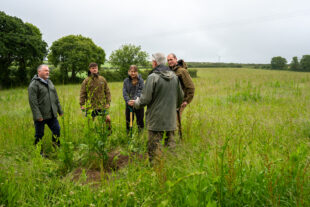https://defrafarming.blog.gov.uk/provide-nest-boxes-for-birds/
Provide nest boxes for birds
The guidance on this page is for SFI pilot participants only. Please visit GOV.UK for the official Sustainable Farming Incentive scheme guidance.
Find out how land managers can help maintain or increase the numbers of rare or threatened bird species by providing nest boxes.
If you’re completing this action as part of the Sustainable Farming Incentive pilot, how you do it is up to you.
The advice on this page can help you get better environmental and business benefits, but you do not have to follow it to get paid.
Nest boxes for birds
A lack of natural nesting sites can limit the size of bird populations. Putting up nest boxes provides nest sites for cavity or hole-nesting birds.
Nest boxes help maintain and increase the numbers of some rare or threatened species.
To maintain or increase bird populations, you also need to provide birds with year-round food sources alongside nest boxes.
You can provide nest boxes for:
- barn owls
- kestrels
- tree sparrows
- willow tits
- pied flycatchers
- swifts
- house martins
Use the National Biodiversity Network to find out what species are present in your area.
How to put up nest boxes
Nest box design
You can either buy or make your own nest boxes.
Make sure your nest boxes:
- are made from untreated wood or a wood and concrete compound, so boxes are weather resistant and insulated
- use responsibly sourced materials, like Forest Stewardship Council (FSC) certified wood
- have drainage holes to stop the box getting waterlogged
- are as safe as possible from predators
- are the right design for the species you want to target
You can put up nest boxes at any time of year. The best time is in winter before birds start looking for nesting sites.
Find out more about putting up nest boxes from the British Trust for Ornithology.
Where to put nest boxes
Make sure nest boxes are:
- sheltered from strong sunlight and the prevailing wind and rain
- away from each other, as neighbouring birds can be aggressive
- away from other feeding areas for birds, as feeding activity disturbs nesting birds
- hard for predators like cats to reach
Do not put barn owl or kestrel nest boxes close to open areas used by ground nesting birds. You do not want to encourage birds of prey to predate the chicks of rare or threatened birds, including seabirds and waders.
Nest boxes for different species
Nest boxes for barn owls or kestrels
Barn owls and kestrels will use very similar nest boxes. Nest boxes should be at least 1km away from major roads and have:
- a nest chamber floor area at least 40cm by 40cm
- an external platform below the entrance hole, big enough for all young birds to exercise
- thick roofing felt if the box is outside
Boxes can either be in an open building or outside.
Barn owl boxes need to have an entrance hole:
- ideally 10cm by 13cm, up to 15cm by 15cm
- at least 46cm from the floor of the nest box
Kestrels boxes need to have an entrance hole at least 10cm by 10cm, up to 21cm by 30cm. There should be 10cm from the floor of the nest to the bottom of the entrance hole.
Find out more about building and siting barn owl boxes from the Barn Owl Trust.
You can allow local volunteers to annually monitor barn owl boxes and ring the chicks. Volunteers must have a Schedule 1 licence to check barn owl boxes during the breeding season.
Nest boxes for tree sparrows
You can put several nest boxes close together, as tree sparrows nest in groups.
Put nest boxes on farm buildings or hedgerow trees, ideally near permanent water.
Make sure the entrance hole is 28mm in diameter. This size makes tree sparrows most likely to use the box, not other species.
Nest boxes for willow tits
Willow tits will not nest in a normal nest box design. They excavate their own nest holes each year in standing rotten dead wood.
You can create standing dead wood by fixing rotting silver birch, elder or alder logs to living trees. Logs should be big enough for a nest bowl 85mm in diameter.
Willow tit nest boxes need to be tall and thin to mimic rotten stumps and branches. You can fix a thin layer of dead bark to the front of the box to make them look like dead wood.
Boxes need to be at least 120mm in diameter. Fill them with wood chip or damp sawdust, so willow tits can excavate their own nest hole.
Use nest boxes:
- in existing willow tit territories only, as they do not move far to spread into new areas
- where there is little standing dead wood
- if nesting success is low due to predators, or due to other bird species taking over nest sites
Nest boxes for pied flycatchers
Pied flycatchers spend winter in West Africa and return to England in April to nest.
Pied flycatcher nest boxes need to:
- have an entrance hole 28mm in diameter
- be in small groups
- face south-east to provide some warmth in the spring while avoiding prevailing wind and rain
- be close to areas of open woodland
- be blocked up until late March or early April to stop other species from using the boxes
Nest boxes for swifts
Swifts spend most of the year in tropical and southern Africa and return to England in May to nest in building cavities, normally in groups.
Nest boxes can be inside or outside. Boxes inside buildings are more secure and the temperature is more stable.
You can attract swifts to new nest boxes by playing a recording of their call.
Swift nest boxes need to:
- have an oblong or half-moon entrance near the floor of the box
- have a nest chamber at least 12cm wide and 7.5cm high, with a floor area of 350 square centimetres
- be at least 5 metres from the ground
- have a clear flight line to the entrance hole
Find out more about building and siting swift boxes from Swift Conservation.
Nest boxes for house martins
House martins spend winter south of the Sahara in Africa, returning to England in mid-May to nest on buildings under overhangs.
House martin nest boxes are widely available. They:
- are the shape of a quarter sphere
- have entrance holes 65mm wide and 25mm tall
- can be placed together in groups
How to clean nest boxes
You’ll need to clean nest boxes after each breeding season to stop parasites building up.
Birds, nests and eggs are protected by law. You must make sure all nesting has finished before you clean nest boxes.
Only clean nest boxes between 1 September and 31 January once birds have finished nesting.
Follow these best practice steps when cleaning a nest box:
- Wear gloves and a mask to protect yourself from fungi and bacteria.
- Be careful of fleas, lice and ticks.
- Remove any nests or nesting material by hand.
- Destroy any dead eggs - it’s illegal to keep them.
- Check the box to see if it needs repairing or replacing.
- Pour boiling water into the nest boxes to kill any remaining parasites or their eggs.
- Do not use insecticides or other chemicals.
- Let the nest box dry out thoroughly.
- Close the nest box or fill it with woodchip for willow tits.
You do not need to clean swift nest boxes unless sparrows have used them.
If nest boxes stay empty
It may take a few years for birds to use a new nest box. If your nest box is empty for more than 5 years, try moving it to another location.



